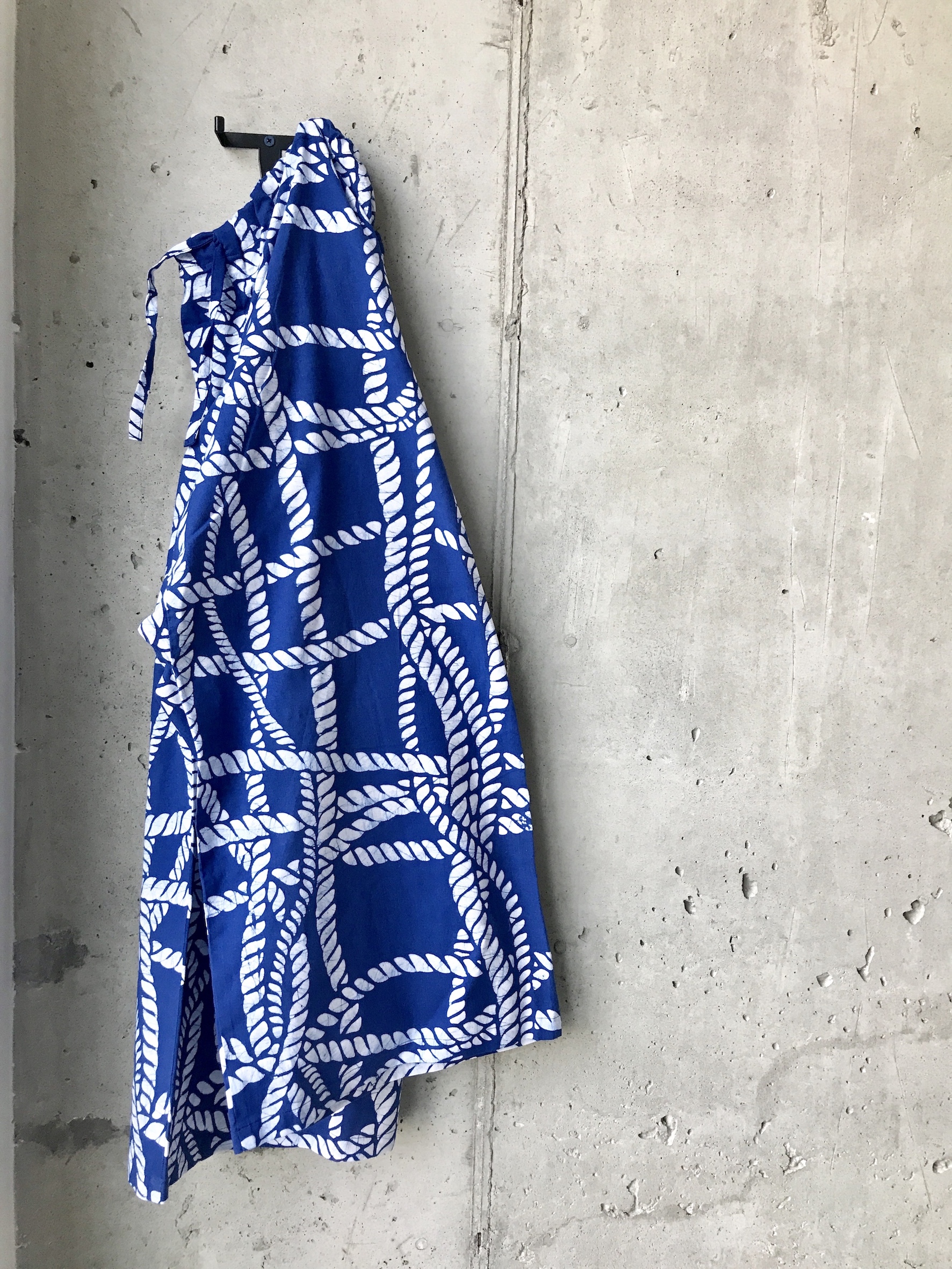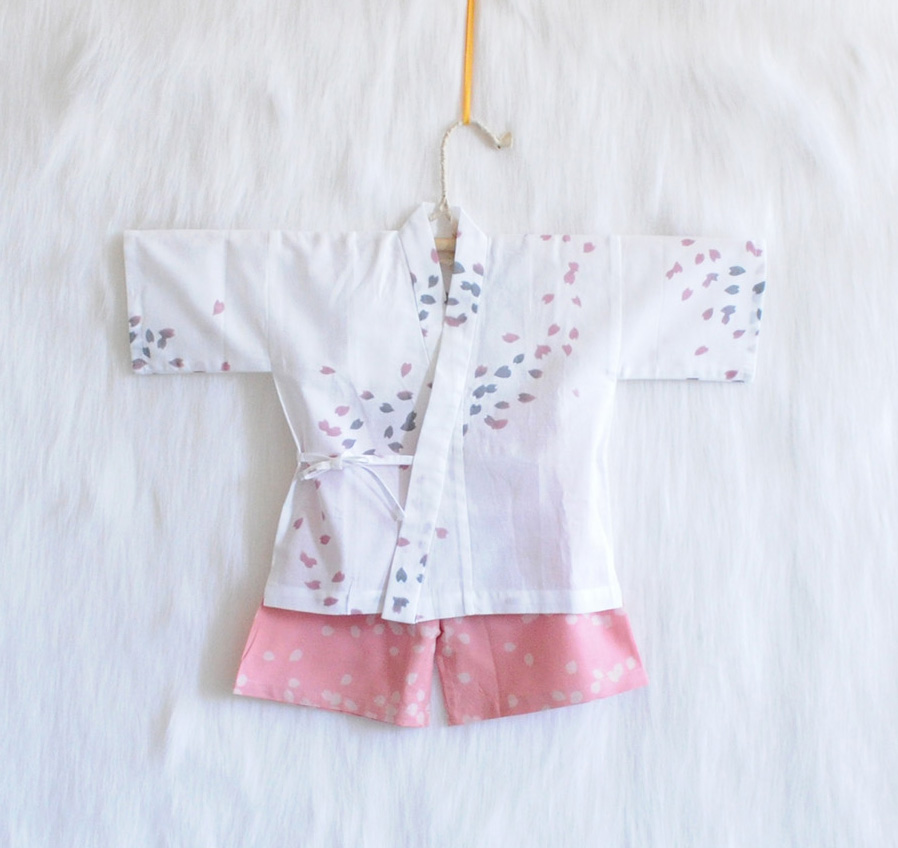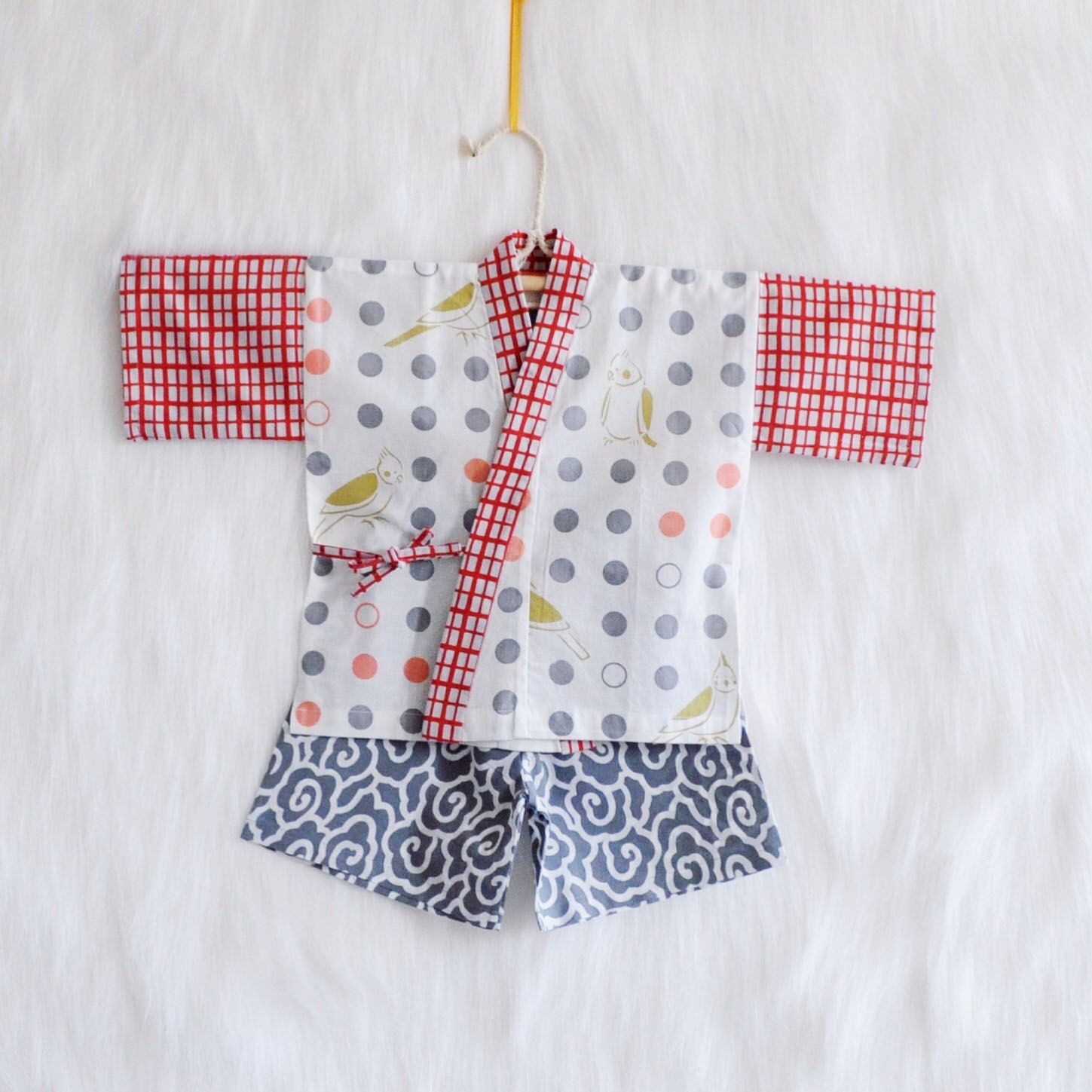For summer of 2018, we'll be making several ZUTTO pants designs in limited quantity. This one above uses Todaya's "nawa (rope)" textile, which is dyed with combination of batik and "chusen" technique. Bold and bright, and secretly luxurious (such involved process to make this textile).
Ahiroya あひろ屋 an exceptional "chusen" textile maker
Ahiroya is an exceptional textile maker among others, which use the traditional "chusen" technique. "Chusen" is an old technique, which involves several artisans including an artisan to make the paper stencil and an artisan to dye the textile. Other makers warashi-ko purchases the textiles from are both over 100 years old shops, which have stocks of drawings and stencils from the old days, and also have a network of artisans within the specific field. Thus, it is a completely different process to start on its own without any base or background, like Ahiroya did.
warashi-ko found Ahiroya when we were looking for baby/toddler girls' jinbei textiles. We wanted something not too sweet but soft and lovable. Ahiroya's "hana ikada" and "sakura" were just so perfect, and warashi-ko's jinbei made with those textiles are loved by young and old from all over the place.
We love Ahiroya designs, that have good balance of tradition and contemporary feels. We are excited to expand our line of collection from kids' jinbei to grown-ups pants, azuma totes and more since that opened up new venues to use all kinds of other Ahiroya textiles, which we didn't use before!
Above: 1. hana ikada + sakura, 2. sakura + sakura, 3. seigaiha + kurage, 4. origami + mame shibori (Todaya)
あひろ屋さんは、野口さんが一人で切り盛りされているお店だ。取扱う手ぬぐいは、全て野口さんによるデザイン。古典柄を独自の線や色で表現したものや、愛鳥や植物に囲まれる毎日の生活から生まれたデザインなど、野口さんの人柄を思わせる優しい印象のものが多い。
わらしっことあひろ屋さんが出会ったのも、そんな優しい印象の生地を、女の子向けの甚平を作るために探していた時のこと。あひろ屋さんの、「花筏」や「桜」は、探していたイメージにピッタリだった。甘くなり過ぎない色。古典過ぎず、現代的過ぎない、あひろ屋さんのサクラ。「花筏」と「桜」で作った甚平は、老若男女、国内外を問わずわらしっこの人気甚平である。
あひろ屋さんのスゴイところ。それは、他の染屋さんと仕事をするうちにハッキリしてきた。わらしっこは、あひろ屋さんの他に、戸田屋さんと三勝さんから生地を仕入れているが、両店とも100年以上続く老舗である。ということは、100年以上昔から伝わる図柄があり、型紙があり、職人さんネットワークがある。それに比べて、あひろ屋さんは、その土台が無かったところを、一人で一から築いてきたのである。図案を起こし、型紙を彫ってもらい、注染の職人さんに染めてもらう。それを、コツコツコツコツ繰り返し、現在は50柄、色のバリエーションは更にある。生半可ではない。
甚平から始まったわらしっこのラインアップには、現在オトナパンツや吾妻袋なども加わっている。作るものの幅が広がると、それに合った生地の幅も広がる。子ども用甚平では選ばなかったデザインを使えるので、またそれぞれの柄と、新しい付合いが始まったような気がする。野口さんが一つ一つ丁寧に生み出した柄を、大切に使わせてもらいたいと思う。
Mr. Shimizu next to his father's hand-dyed yukata textile at the Yukata Museum.
Sankatsu 三勝 embrace the old and innovate for now
Yukata Sankatsu was established in 1894, and has been producing the high-end yukata summer kimono for over a century. An attached Yukata Museum displays some of their finest works, and they are simply breathtaking.
Mr. Shimizu in the picture above is standing next to a work by his father, who was named a Living National Treasure. You cannot see the finest details of the pattern unless you are within 12" close to it. It's that detailed. This particular textile, for an example, was created, using more than 10 layers of patterns. Each pattern is hand-curved by an skilled artisan. A highly skilled artisan like Mr. Shimizu would, then, place a paper stencil on a small section at a time to dye a role of yukata textile (usually 11-12m long) without any gap, and he repeated this 10+ times at the exactly same place to dye this textile. For this kind of incredible skill, he was named a Living National Treasure.
This level of work is impossible to be done anymore. Back then, people started apprenticeship after they graduated elementary schools and artisans were finally considered "skilled" when they were in their 50s. It just means that this kind of work needs beyond-imaginative amount of practice. There are rarely those artisans with that much practice nowadays in neither hand-cut paper stencil nor hand-dyeing field. It's just a different time - people usually start apprenticeship later in their lives.
ゆかたや三勝は、創業明治27年の老舗であり、その名の通り、こだわりの浴衣を世に送り出してきた。三勝に併設する「ゆかた博物館」では、その技術と歴史の一部を垣間見ることができるが、圧巻である。
清水氏が立っておられる横にあるのは、父上である人間国宝・清水幸太郎氏による浴衣生地である。貝合わせの絵柄であるが、どれだけ微細な柄であるか、お分かりいただけるだろうか。多分、実際に見ていただかないと無理である。このような細かい柄を染めるには、10数枚の型紙を必要とする。もちろん一枚一枚の型紙は、熟練した職人による手彫りである。その型紙を生地の上に置き、糊を置いていく。この作業を浴衣生地分、11〜12メートル、しかも10数枚の型紙で一寸のズレもなく繰り返していく。想像を絶する人間業である。その卓越した技術を持っていたのが、清水幸太郎氏であり人間国宝である所以だ。
この「貝合わせ」のような生地は、もう染めることができない。清水幸太郎氏が生きた時代は、小学校を卒業すると丁稚奉公に出て、職人の修行を始めた。それから毎日毎日修行を重ね、やっと50歳になる頃に熟練した職人と見做されたそうだ。だから、今の時代、高校を卒業してから修行を始めるようでは、型紙を彫る職人にしても、染めの職人にしても、昔の域までは中々達することができないそうだ。また、職人の絶対数にも、昔と今では大きな違いがある。
奢侈禁止令により、町人が贅沢な絹の着物を着ることが許されなかった時代、負けん気の強い江戸っ子たちは、綿の浴衣生地に贅沢を尽くして粋を競った。その時代に生まれたのが、このような超越した作品であり、それを生む職人の腕であった。
Sankatsu is an attractive company after 100+ years. They still use the drawings from 100+ years ago. For example, "sakura" of warashi-ko's "ama sakura" jinbei and "kiku" of "kiku zutto" are also based on 100+ years drawings. Both have such an elegant flow throughout, created by connecting flowers, leaves and such. Hand-cut paper stencils has to be remade at some point and has to be adjusted to the new standards, in terms of width of kimono textiles. Sankatsu keeps the stencils well maintained and dyes with new colors and various textiles every year to meet the needs of now.
今の三勝。それは、古きを大事にしながら、新しい時代に挑戦し続ける老舗と言えるだろう。創業100年余の三勝は、100年も以前から使われている図案を未だに使っている。warashi-ko甚平の「ama sakura」に使われている「桜」の図案や、「kiku zutto」の「菊」もそうである。枝や葉、大小の花が連なり、画面を優美に飾る情景は、今では中々描ける人がいないという。型紙には寿命があり、また生地幅も時代によって変わることから、型紙を作り直しながら大事に使っている図案である。そして、同じ型紙でも、色を変えて染めたり、生地を変えて染めたり、様々な工夫をしながら時代の好みに合ったものづくりをされている。
The current CEO (right), the third generation, and the fourth generation (left)
It's a pleasure to work with the Sankatsu family. They are kind of people, who cannot disregard even a small bit of textiles since they involved hard works by the artisans. We look forward to working with them far into the future.
三勝を担う、天野家や社員の人柄も魅力的である。
今年、わらしっこがお邪魔した際に、新しい商品を見せていただいた。ハギレや百貨店には受け入れられなかった多少難ありの生地である。けれでも、このような生地も、職人が一点一点手をかけて作ったものであるから捨てられない。その気持ちから生まれた商品である。
わらしっこ日本上陸。お店+ギャラリー・パートナー大募集!
日本の皆さま、こんにちは!先週、東京に到着し、母子共々ようやく時差ボケが治りかけてきました😅
さて、まだまだ未熟なわらしっこですが、甚平発祥の地、日本でも根を張っていきたいと思っています。そこで、わらしっこ甚平を取り扱ってくださるお店やギャラリーを大募集です😆もう今年の予定は決まっていると思いますので、来年のご相談でも大歓迎。7月末まで日本におりますので、お話しできたら嬉しいです。
わらしっこ甚平は、ブルックリンで生まれた甚平ブランド。元気な子供たちに、(大人にとっても)一生の思い出になる程、かわいくタフな甚平を着せたい。ニューヨークの街中へもお出かけできる位、カッコカワイイ甚平をモットーに、手染め生地を使ってデザインしています。
素材は、浴衣と同じ生地+染め方(注染)で作られているあひろ屋さんや梨園染 戸田屋商店さん、それに浴衣の老舗三勝さんの手ぬぐいです。軽く、涼しく、吸収力抜群、速乾、ヘタレず、多少の色落ちも味になる程。先人の知恵が生かされた生地に、いつも脱帽しています。これを、曾祖母さんの知恵の詰まった形に仕上げているので、成長の早い子供でも2〜3年は着られます。縫製パートナーのShingo Okamotoさんの仕事に間違いはありません😉
日本の素晴らしい技術や伝統をつないでいきたい思いで作っています。伊勢型紙や注染の技術のことも、まだまだ知らないことばかりですが(伊勢型紙や注染と一口に言っても、その工程に複数の職人さんが関わることなど最近知りました!)、関わって下さる皆さまと一緒に勉強していきたいと思っています!ご興味のある方は、hello@warashi-ko.comまでご連絡ください。
Mr. and Ms. Okamoto
Reasons for "Made in Japan" | 日本製の意味。わらしっこの縫製パートナー。
During our stay in Tokyo last summer, we had a chance to meet with Mr. and Ms. Okamoto, who run a sewing studio in Okayama Prefecture.
warashi-ko wouldn't be up and running without help from Mr. and Ms. Okamoto nowadays. warashi-ko's designs are much more complicated, compared to standard jinbei, which uses the same textile for top and bottom. We often combines 2-3 textiles at diffident parts, like collar, strings, sleeves and body. We also order only small number of sets each time. So we are not completely ideal client (time-consuming + small orders) but they listen to our detailed requests, and always make beautifully stitched pieces. We are so greateful of their work!
warashi-ko is dedicated to using Japanese hand-dyed textiles, using hand-cut stencils, because the handwork is incredible and we should use them to keep them alive. When we looked for sewing help, we also looked in Japan because we've seen places struggle when a significant part of sewing work went overseas. Some regions in Japan developed with the sewing industry, but when jobs were no longer offered to them, they struggled with large factories with idle machines. Even in this kind environment, however, studios, like Mr. and Ms. Okamoto still have chance. They have a compact studio and they assign rest of orders to sewers, who independently work from their homes. This way, they are more flexible with changing demands. They are able to accept small orders.
Just like other sewing companies in Japan, Mr. and Ms. Okamoto's studio once lost its significant part of work when most Japanese companies went overseas to make garments cheaper. Now, however, with Tokyo Olympic in near sight, Japanese are coming back to "made in Japan" products, and they've had very busy year so far. They are most surprised themselves.
We have no complaints about increasing popularity in Japanese products. But this shouldn't end when the Olympic is over. We probably need to train ourselves in appreciating real hand works and things made with care.
岡山県に工房を構える、岡本さんご夫婦。 昨年の夏、東京へ帰っていた際、わざわざお時間を作って会いに来て下さった。
わらしっこは、今や、岡本さんの助け無しには成り立たない。わらしっこがお願いする甚平は、2種類、3種類の生地を、それぞれのデザインによって襟・袖・見頃・紐と、上衣だけでも組合せを変えているものが多い。一般的な甚平(全身同生地) よりも、格段に手間がかかる。しかも少量ずつしかお願いできない。それなのに、引き受けて下さる。しかも、いつも安定の丁寧な出来栄え。細かくお願いしている生地を使う方向まで、二度お伝えする必要がない。素晴らしい!!の一言。岡本さん、本当にいつもありがとうございます!!
わらしっこは、手仕事で作られた生地にこだわっているが、縫製をお願いする際も、日本国内で探した。縫製業の多くが国外へ流れ、縫製に携わってきた地域が主幹産業を失い苦しんでいる現場を目の当たりにしてきた。大きな工場を持っていては、大量生産の需要が無ければ、遣り繰りの目処が立たない。でも、岡本さんの所のように、コンパクトな工房と、各家庭で作業する縫い子さんを抱える二重体制だと、需要の振れ幅にも対応することができる。少量生産にも対応することができる。
岡本さんの所でも、注文が一気に落ち込んだ時期があったそうだ。日本企業が、一斉に、安い国外での縫製を望んだ頃だ。しかし今、オリンピック開催に向けての機運が高まる中、日本製・made in Japanが再度求められるようになり、今年は大忙しだそうだ。正に嬉しい悲鳴。
でも、オリンピックが過ぎたら、また同じ状況では困る。もっと皆んなで、素晴らしい技術を見る目、大切に作られたものを尊ぶ心を養っていかなければいけないな、と思う。
熱っぽいネコちゃんのような娘連れで、ご迷惑おかけしました〜。
A journey to make this pants
I visited Milk Crown Farm in Ishigaki Island for yummy ice cream last summer. The owner saw my kids' jinbei, and she liked them. So when I went to Arimatsu, I purchased this "itajime" dyed textile from Harisho with her in mind. The textile remained unused almost a year, and now it's reborn as relaxed pants. This time, my friend Ayumi and her friend in NY were the source of my inspiration and motivation.
This pants is made with similar principles to kimono making. It's based on rectangular parts and straight stitches. This way, the pants is really easy to take it apart and make into something else, like jinbei! Inheriting lovable things. Pants' back: あひろ屋 jellyfish
石垣島のミルククラウンのオーナーが、わらしっこ甚平を気に入ってくださって、こんなのが欲しいなあ。と言ってくれたのがきっかけで、有松の張正さんに行った際に買った板締めの反物。女性もの甚平のイメージが湧かずに、1年近く眠っていたけど、今度はNYのあゆみさんとソフィアさんの声で目覚め、カッコ可愛いパンツとして生まれ替わった。こんな風に、色んな人の声によって、モノがカタチになっていくこともあるんですね。
ちなみに、こちらのパンツ。手ぬぐいにしたら4枚からできていて、和裁にように長方形パーツ+真っ直ぐ縫いなので、将来、子ども甚平に作り替えちゃうことだって出来ます。着繋いでいけるモノ。大切なポイント。パンツの後ろは、あひろ屋さんの海月(紺)です。
jinbei making workshop | 甚平作りワークショップ
It’s been really fun to make jinbei with participants at workshops, so we decided to add some more dates before the warm jinbei weather arrives!!
This time, participants can choose from the 5 warashi-ko designs to make your own jinbei!
The size is for 0-2 year old. (If you are interested in making one for 2-3 year old, let us know. We may be able to accommodate as well!) Handmade wardrobe adds such special memories to the precious childhood. With adjustable strings, babies/kids can wear the same jinbei for 2-3 years, so your work will be definitely rewarded!
Material fee: $45
Included are 3 tenugui textile, thread and guidance until your jinbei is complete!
Dates:
WED 3/23 13-15pm
WED 3/30 10-12pm
SAT 4/2 10-12pm
*We aim to reach the first mark of the jinbei-making process during the workshop, i.e. putting on the collar. We’ll follow up either by setting up another appointment or through video instructions until your jinbei is complete!
Place:
Warshi-ko studio (2 blocks from 15th street/Prospect Park F/G stop)
Sign-up by 3/6/2016
Please send an email to hello@warashi-ko.com for questions and reservation.
From left to right: #026 yagasuri kumo, #030 ume sakura, #023 kabuki ichimatsu, #034 okame kumo, #028 ume ume
赤ちゃん&子ども甚平作りワークショップ
NYは暖かくなり始めると、一気に初夏のような気候になりますね。
そんな時期を前に、一緒にチクチク子どもの甚平を作りませんか?
わらしっこは、ニューヨーク生まれの甚平です。着心地と丈夫さを大事にしながら、ニューヨークの街に着て出かけて行けるスタリルを提案しています。
今回のワークショップでは、 わらしっこ甚平の5つのデザインの中から一つを選んで、甚平作りに挑戦します。使用するのは、手染めの日本製手ぬぐい。甚平のサイズは、0歳から2歳児用です。(ご希望であれば、100cmサイズも作ることができます。)真心の籠った甚平を、子どもの宝物のような時間のお供に。紐で調整できるため、2〜3年は着られます。
材料費:$45 手ぬぐい3枚(注染)含む。
日時:
3/23(水) 13-15pm
3/30 (水) 10-12pm
4/2(土) 10-12pm
*一回のワークショップ参加で、襟付けまで辿り着くことを目標としています。その後は、再度集合またはメール等でフォローアップし、完成を目指します。
*1歳以下のお子様連れでの参加も可能ですが、その場合参加人数に限りがありますので、ご相談させてください。
場所:
Warshi-ko studio (2 blocks from 15th street/Prospect Park F/G stop)
申込みは、3/6/2016まで、hello@warashi-ko.comへお願いします。ご質問等も、お気軽にどうぞ。
jinbei making workshop | 甚平作りワークショップ
One of the luxuries of cold months is to stay warm cozy with a good company. How about we make jinbei together while thinking about babies and blossoming spring!
You can choose from the 4 warashi-ko designs to make your own jinbei.
The jinbei size is for 0-2 year old.
#014 umi to kurage
#017 sakura zukushi
#018 hana asobi
#020 kurage in the paradese
Fee: $45
Included is material for making jinbei (3 tenugui textile) and guidance until your jinbei is complete!
Dates:
WED 2/24 13-15pm
WED 3/2 13-15pm
*Participate either or both dates. You’ll probably not finish making jinbei during the workshop, but we’ll send you home with instructions and you can contact us anytime!
Place:
Warshi-ko studio (2 blocks from 15th street/Prospect Park F/G stop)
Sign-up by 1/31/2016
Questions? Let us know!
From left to right: #018 hana asobi, #017 sakura zukushi, #020 kurage in the paradise, #014 umi to kurage
赤ちゃん甚平作りワークショップ
寒い時期に、ぬくぬくの部屋で、一緒に赤ちゃん甚平を作りませんか?
わらしっこは、ニューヨーク生まれの甚平です。
ワークショップでは、 わらしっこ甚平の4つのデザインから一つを選んで、甚平作りに挑戦します。使用するのは、手染めの日本製手ぬぐい。甚平のサイズは、0歳から2歳児用です。真心を込めて、赤ちゃんが数年着られる甚平を作りませんか?
デザイン:
#014 umi to kurage
#017 sakura zukushi
#018 hana asobi
#020 kurage in the paradese
参加費:$45
甚平の材料、手ぬぐい3枚(注染)を含む。
日時:
2/24(水) 13-15pm
3/2 (水) 13-15pm
*どちらか一日または両日参加していただくことができます。ワークショップ時間内に、甚平は完成しないと思いますが、甚平完成までメール等でフォローアップいたします。
*参加者は、日本人に限りません。
場所:
Warshi-ko studio (2 blocks from 15th street/Prospect Park F/G stop)
申込みは、1/31/2016まで。
hello at warashi-ko.comへお願いします。
ご質問等も、お気軽にどうぞ。
Traditional Machiya (townhouse) style shop, specialized in shibori
Shibori town Arimatsu || 世界に通用する言葉「shibori」と、絞りの町・有松
Shibori is an over 400 year old Japanese technique of dyeing fabric wrapped with thread and folding in particular ways to create specific patterns (essentially a very advanced and meticulous form of tie-dye). And it was a Shibori jinbei that inspired us to start warashi-ko, and we are huge fans. We also recently realized how much shibori fans are spreading out worldwide.
In 1992, World Shibori Network (WSN) was established in Arimatsu, the mother town of shibori, and the 10th International Shibori Symposium is planned in Mexico next year. Textile Arts Center in New York is hosting shibori workshops, and other people in town are talking about shibori and creating their own works. It’s incredible.
On the other hand, if you visit Arimatsu now you wouldn’t get the sense that it is the most happening place. It is like a grandparent’s house that was left quiet after everybody grew up and moved to different places.
Arimatsu grew with the development of shibori since 1600s, and the regional structure that was built around it produced amazing works. There were artisans specialized in making paper stencils for drafting designs, artisans devoted for threading the designs, dyeing the fabric, stretching out the fabric, and stores specialized in selling the shibori textiles. The industry is based on division of labor, and local people grew up with shibori by their sides. Kids started learning how to thread beside their parents and grandparents, and by the time they became adults they were unrivaled experts. That’s how it used to be.
Time is changing now, and kids no longer grow up practicing shibori. Most of the experienced artisans are elderly. And the few younger artisans have a different work style from their elders. Older generations worked on shibori as part of their daily life, in between their house chores. But younger generations treat it as “work” and the time involved as the cost of labor--resulting in higher prices. Overall, the local shibori artisan pool is shrinking, and there are fewer exceptional artisans every year.
There are still some people who are drawn to Arimatsu these days with the hope of revitalizing it. There are new shibori artists and residents, and emerging brands like SOU・SOU bring contemporary textile designers to town to create new types of products. And there is a trend in Japan to support traditional artistries in general. And certainly, the growing shibori community can be big supporters for Arimatsu.
The heart of shibori is in Arimatsu, and shibori culture needs the strong regional base to grow further. Arimatsu and shibori’s potential is still unknown, but it's not done for yet. There are many paths it may go down, and hopefully it's not too late to recognize some of the Arimatsu-made exceptional shibori textiles as more than artisanal product, but as true works of art.
世界に通用する言葉「shibori」と、絞りの町・有松
絞り染めを指す「shibori」が、グローバルに通用する言葉になっていることをご存知だろうか。絞り甚平が原点の「わらしっこ」だが、ニューヨークに身を置いて、「shibori」の言葉をよく耳にするのに驚いている。
1992年、世界中の「shibori」研究者や愛好家が集まり、第一回国際絞り会議が有松で開催された。その際、ワールド絞りネットワーク(WSN)が設立され、 来年には第十回シンポジウムがメキシコで開催される。また、ニューヨークでも、テキスタイル・アーツ・センターを中心に、絞りワークショップが開催され、多くの参加者を集めている。米国では、1960年代に流行った 「tie-dye」も根強い人気があるが、シンプルな技法を用いて、原色の組み合わせを楽しむところが「shibori」とは違っている。
さて、一方で、絞りの里・有松であるが、こちらは「shibori」が世界的に注目を集めているという事実とは無関係のように静かである。時代の流れと共に、絞り製品の捉えられ方や町の人々の絞りへの関わり方は、変わってきた。最盛期が過ぎ、今後の方向性を模索しているところと言えるだろうか。
有松は、江戸時代に幕府の保護を受け、絞りと共に発展してきた。町には、下書きのための型を彫る職人が居て、くくりを担う職人が居て、染色職人、湯のし職人、絞り生地を専門に扱う商店があった。町が絞りと共にあり、町の子供たちは、親や祖父母が絞りの制作に関わるのを傍で見ながら覚えていった。ほとんどの地元民が絞りに関わり、子供達が成人する頃には、ある程度の知見と技術を持っていた。
しかし、時代が変わり、人々の、町全体の絞りへの関わり方も変わってきた。子供達は深く絞りに関わることなく大人になる。後継者が減り、今でも続けている職人はお年寄りが多くなってきた。お年寄り職人にとっては、絞りが生活の一部であり、家事の合間に作業を進めることも多い。若い人にとって、作業は「仕事」であり、作業時間は経費として換算する。現代では当たり前のことであるが、これでは「絞り」製品の値段は高くなりすぎてしまう。
有松には新しい風も吹き込んでいる。若い作家や、まちづくりに関わる移住者。SOU・SOUのように、外部からのクリエイターと一緒に新しい商品開発を仕掛けるブランドもある。日本全体で、伝統工芸や昔の生活様式を見直す動きが、これらの動きを後押ししている。
多くの魅力を持って、たくさんの人を惹きつける「絞り」。その原点である場所・有松は、これからも「shibori」文化の核として発展していってほしい。世界の愛好家には何ができるだろうか。わらしっこには、何ができるだろうか。
Photo credit: Robert Bredvad
Kourai-koshi || 200+ year old Kabuki born pattern
Bright red against light gray, thin cross inside thick cross pattern, this design is based on a Kabuki actor’s costume.
During the Edo era, the Kabuki actors were the trendsetters. In the famous Kabuki play called “Suzu-ga-mori”, Koshiro Matsumoto IV wore a rain jacket with this pattern at a key scene. The play became so popular, that the pattern became a trend, and it was named after Koshiro Matsumoto’s stage name “Koraiya”.
“Koraikoshi” is worn in portraits of Koshiro Matsumoto IV, and in ukiyo-e depicting the play “Suzu-ga-mori.” It is still worn by Koshiro Matsumoto IX today.
The sizes of the plaids and the color combinations have slight variations, but Todaya’s “Korai-koshi” is a perfect accent to many warashi-ko jinbei. I always think it’s amazing to wear a pattern that has been around over 200 years.
Above left: Kōshirō Matsumoto IV (1737–1802) as Sakanaya Gorobee, in the 1794 production of Kataki-uchi Noriai Banashi by Tōshūsai Sharaku
Above right: Suzugamori on the pamphlet for 27th Konpira Kabuki from Aoitori no Shiawase Sagashi
高麗格子|今着る歌舞伎生まれの柄
一般に「高麗屋格子」と呼ばれる、歌舞伎の衣装から生まれたこの柄は、太い十字の中に、細い十字をあしらったデザインである。
歌舞伎役者が流行の発信だった江戸時代。四代目・松本幸四郎が、「鈴が森」で幡随院長兵衛を演じた際に着ていた合羽の柄が出どころである。この演目が大変評判となり、松本幸四郎の屋号である「高麗屋」にちなんで「高麗屋格子」と名付けられたと言われている。
四代目・松本幸四郎を描いた浮世絵や、「鈴が森」を描いた浮世絵の中でも、「高麗屋格子」を纏っている姿を見る事が出来る。また、現在も「鈴が森」の中では、変わらず「高麗屋格子」が使われている。
浮世絵の中では、格子柄や色合いが少しずつ違っているが、戸田屋商店の「高麗格子」は、わらしっこ甚平にとっては、スパイスを加えてくれる欠かせないパートナーだ。表舞台に登場してから200年以上経った今、甚平の柄として着るのも中々粋だと思う。
Image credit: Robert Bradvad
Shibori jinbei || 絞り甚平
I’m grateful for Robert Bradvad, a talented photographer based in NYC, for taking such beautiful pictures of warashi-ko jinbei.
I was especially thrilled to see the shots he took of the shibori jinbei made by my son's great grandmother, since it was what originally inspired me to start warashi-ko.
Shibori is such an impressive technique, which involves intense skilled handwork. The pattern in this shibori jinbei is called Kanoko. In order to make this pattern, an experienced artisan has to wrap thread around pinch of fabric as many times as the number of small patterns you see on the textile. It’s hard to imagine the amount of labor, time, and patience involved in making textiles like these. It's exactly because of this effort that shibori has its characteristic beauty and strength.
This Kanoko used to belong to my grandmother as part of her summer kimono. Kanoko is perfect for the summer since the bumps on the textile, made by wrapping the threads, give air a space to flow between the cloth and the wearer--keeping you cool and comfortable during the hot weather. My grandmother enjoyed wearing this yukata, and when my first son was born, she decided to pass it on to her great grandson turning it into a jinbei for him.
So while shibori is expensive, there aren't many fabrics that can stay strong and beautiful for four generations. And it will always be one of my favorite jinbei.
Warashi-ko uses artisan-made textiles because they are beautiful, tough, can last generations, and using them is the only way to keep the incomparable handwork it takes to make them alive.
ニューヨークを拠点に活動する写真家ロバート・ブラッドバッドさんに、わらしっこ甚平の写真を撮っていただいた。いただいた写真を見て、そのディテールを捉えた美しさに感動したが、特に嬉しかったのが、絞り甚平の写真をたくさん撮ってもらったことだった。
鹿の子絞り甚平は、わらしっこの原点である。日本人なら知っている方も多いと思うが、鹿の子絞りは、熟練の職人の手作業によって、一つ一つの模様を、糸を巻きつけることで作っていく。総鹿の子ともなると、気の遠くなるような労力と時間、忍耐を要する。そんな生地であるから、もちろん高価である。普通は、子供の甚平には使われない。ただ、この生地が息子の甚平になり得たのは、それが元々曾祖母の浴衣の生地であり、曾祖母が十分に着た後に、曾孫の為に甚平に作り変えたものだからである。
鹿の子絞りは、絞りによって出来た突起があるため生地が肌に密着せず、夏でも涼しい。皺になりにくく、丈夫。何十年経っても、たくさん着ても洗っても、へたることなく気品がある。そんな絞り甚平に感動したのが、わらしっこを始めたきっかけである。
絞りは高くて中々使えない代わりに、わらしっこは、昔ながらの手作業によって作られた手ぬぐいや浴衣生地を使用している 。成長の早い子供でも2〜3年は着られるわらしっこ甚平。 一人が着終わった後にも、他の子に受け継いでもらったり、他のものに作り変えたりして、丈夫で良い生地を受け継いでいってもらえればとても嬉しい。






































